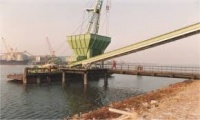Difference between revisions of "Ship Unloading Systems"
(Created page with "Category: Loading and Unloading Equipment{{Knoppen}} <noinclude><!------------------------------------------------ * READ THIS FIRST * Only edit this page if you can imp...") |
PurplePen19 (talk | contribs) |
||
| (One intermediate revision by one other user not shown) | |||
| Line 1: | Line 1: | ||
[[Category: Loading and Unloading Equipment]]{{Knoppen}} | [[Category: Loading and Unloading Equipment]]{{Knoppen}} | ||
* | [[File:Ship Unloading Systems_1.jpg|thumb|200px|right|Ship Unloading Systems]] | ||
* | |||
* | '''Ship Unloading Systems''' are commonly used with the [[Ship Loading Systems]]. These systems offer their operators great versatility in their applications: Whether mobile or stationary, equipped with their own energy supply or supplied with electric power from the outside – they are sized to suit the different needs and can be tailored to the local conditions. The material is typically transferred to conveying systems which are permanently installed on the pier or directly to road or rail vehicles. | ||
* | |||
* | The mechanical ship unloaders are commonly equipped with high-capacity chain conveyors and satisfy all the requirements for achieving efficient and trouble-free materials handling. The enclosed, sturdy conveyors of rain-proof and dust-tight design enable vessels of sizes up to 120,000 DWT (Dead Weight Tons) to be unloaded at throughput rates as high as 1400 metric tons per hour, depending on the specific class of ship. Loading is performed either through belt conveyors or chain conveyors and loading spouts. | ||
* | To prevent dust emissions, the loaders can be provided with a loading head dust suppressor. Systems are possible with throughput rates up to 2400 metric tons per hour. | ||
==Common Advantages== | |||
===Efficient unloading=== | |||
*The semi-automatic driving mechanism of the marine leg allows optimal positioning of the marine leg. | |||
*Automatic unloading to the maximum depth of material inside the ship’s hold. | |||
===Low energy consumption=== | |||
*The mechanical conveying system ensures lowest energy consumption per conveyed throughput. | |||
*Compared to the mechanical unloading technology employed by the Bargolink system, conventional pneumatic barge unloading systems consume up to 100 % more energy. | |||
===Low maintenance=== | |||
*Rugged design and low number of wear parts substantially reduce maintenance cost. | |||
*Gentle product handling | |||
*High product reject rates are avoided. | |||
*The low conveying speed in mechanical conveyors results in most gentle product transport. | |||
==Videos== | |||
<youtube>t2IC6icAZcM</youtube> | |||
Latest revision as of 20:25, 5 September 2013
Ship Unloading Systems are commonly used with the Ship Loading Systems. These systems offer their operators great versatility in their applications: Whether mobile or stationary, equipped with their own energy supply or supplied with electric power from the outside – they are sized to suit the different needs and can be tailored to the local conditions. The material is typically transferred to conveying systems which are permanently installed on the pier or directly to road or rail vehicles.
The mechanical ship unloaders are commonly equipped with high-capacity chain conveyors and satisfy all the requirements for achieving efficient and trouble-free materials handling. The enclosed, sturdy conveyors of rain-proof and dust-tight design enable vessels of sizes up to 120,000 DWT (Dead Weight Tons) to be unloaded at throughput rates as high as 1400 metric tons per hour, depending on the specific class of ship. Loading is performed either through belt conveyors or chain conveyors and loading spouts. To prevent dust emissions, the loaders can be provided with a loading head dust suppressor. Systems are possible with throughput rates up to 2400 metric tons per hour.
Common Advantages
Efficient unloading
- The semi-automatic driving mechanism of the marine leg allows optimal positioning of the marine leg.
- Automatic unloading to the maximum depth of material inside the ship’s hold.
Low energy consumption
- The mechanical conveying system ensures lowest energy consumption per conveyed throughput.
- Compared to the mechanical unloading technology employed by the Bargolink system, conventional pneumatic barge unloading systems consume up to 100 % more energy.
Low maintenance
- Rugged design and low number of wear parts substantially reduce maintenance cost.
- Gentle product handling
- High product reject rates are avoided.
- The low conveying speed in mechanical conveyors results in most gentle product transport.
Videos
